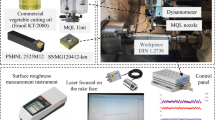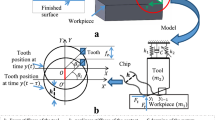Abstract
Improvement in machining efficiency requires better comprehension of multiphysical cutting process phenomenon under real dynamic cutting conditions. Present work suggests a multi-scale interaction of mesoscopic level cutting with macroscopic level machine tool dynamics to optimize cutting process parameters and potentially improve interactive design process. For that, the case of an orthogonal down-cut peripheral milling, for an aeronautic aluminium alloy A2024-T351, has been treated. A finite element based multi-scale dynamic cutting model has been conceived with a commercial finite element based code ABAQUS®/EXPLICIT to predict the chip morphology under dynamic cutting conditions. Later, combines the elasticity of a classical high speed milling spindle system (tool, tool-holder and rotor) with the mesoscopic level chip formation process. A qualitative parametric study with various stiffness and damping coefficient values for high speed milling spindle system shows that, a less rigid un-damped milling system generates higher amplitude tool vibrations during cutting. In this situation, the temperature rises at tool-workpiece interface, enhancing material softening. Present study deals with the consequences of this softening on affecting the chip morphology (evolution of segmented chip morphology), and machined surface integrity. Further, numerical simulation results depict that the higher values of cutting speed and uncut chip thickness are associated with higher values of milling cutter vibration amplitudes.
Similar content being viewed by others
Abbreviations
- A :
-
Initial yield stress (MPa)
- a p :
-
Cutting depth (mm)
- B :
-
Hardening modulus (MPa)
- C :
-
Strain rate dependency coefficient
- c eq :
-
Equivalent linear damping of machining system (kg s−1)
- c eqr :
-
Equivalent rotational damping of machining system (kg m2s−1rad−1)
- C p :
-
Specific heat (J kg−1 °C−1)
- D :
-
Overall damage variable
- D1. . .D5:
-
Coefficients of Johnson-Cook material shear failure initiation criterion
- D T :
-
Tool diameter (mm)
- E :
-
Young’s modulus (MPa)
- f :
-
Feed rate (mm/rev)
- G f :
-
Fracture energy (N/m)
- h :
-
Uncut chip thickness (mm)
- I z :
-
Moment of inertia of the assembly (tool, tool-holder and rotor) (kg m2)
- k eq :
-
Equivalent linear stiffness of machining system (N/m)
- k eqr :
-
Equivalent rotational stiffness of machining system (Nm/rad)
- L :
-
Characteristic length (square root of the integration point element area (mm))
- m :
-
Thermal softening coefficient
- m eq :
-
Equivalent moving mass (kg)
- n :
-
Work-hardening exponent
- N :
-
Spindle rotation frequency (rev/min)
- p :
-
Hydrostatic pressure (MPa)
- Px (i) :
-
x coordinate of the ith tooth of the milling tool (i = 1, 2. . . z t )
- Py (i) :
-
y coordinate of the ith tooth of the milling tool (i = 1, 2. . . z t )
- R n :
-
Tool hone edge radius (μm)
- T :
-
Temperature at a given calculation instant (°C)
- T m :
-
Melting temperature (°C)
- T n :
-
Nodal temperature (°C)
- T r :
-
Room temperature (°C)
- \({\bar{{u}}}\) :
-
Equivalent plastic displacement (mm)
- \({\bar{{u}}_f }\) :
-
Equivalent plastic displacement at failure (mm)
- Δu :
-
Relative displacement of spring element (mm)
- V f :
-
Tool feed velocity (mm/min)
- V C :
-
Cutting speed (m/min)
- z t :
-
Total number of tool teeth
- \({\bar{{\varepsilon}}}\) :
-
Equivalent plastic strain
- \({\dot{\bar{{\varepsilon}}}}\) :
-
Plastic strain rate (s−1)
- \({\dot{\bar{{\varepsilon}}}_0 }\) :
-
Reference strain rate (10−3s−1)
- \({\bar{{\varepsilon }}_f }\) :
-
Equivalent plastic strain at failure
- \({\Delta \bar{{\varepsilon}}}\) :
-
Increment of equivalent plastic strain
- \({\bar{{\varepsilon}}_{0i}}\) :
-
Plastic strain at damage initiation
- \({\bar{{\sigma}}}\) :
-
von-Mises plastic equivalent stress (MPa)
- σ n :
-
Normal stress (MPa)
- \({p{/}{\bar{{\sigma}}}}\) :
-
Stress triaxiality
- τ f :
-
Friction shear stress (MPa)
- τ y :
-
Shear stress (MPa)
- ω :
-
Damage initiation criterion
- ν :
-
Poisson’s ratio
- α d :
-
Expansion coefficient (μ mm−1° C−1)
- α o :
-
Flank/ clearance angle (°)
- γ o :
-
Rake/cutting angle (°)
- λ :
-
Thermal conductivity (Wm−1 C−1)
- ρ :
-
Density (kg/m3)
- ζ eq :
-
Equivalent damping ratio of machining system
- θ :
-
Rotational vibration displacement (°)
- ω r :
-
Angular velocity (rad/s)
- μ :
-
Friction coefficient
- dof:
-
Degree of freedom
- MDC-model:
-
Multiscale dynamic cutting model
- OP:
-
Orthogonal plane
- Path i :
-
Curve traced by TT, i = 1 . . . 5
- Plot i:
-
Curve representing the cutting force (i = 1 . . . 5)
- Profile i :
-
Curve representing the cut surface topology (i = 1. . . 5)
- rpm:
-
Revolution per minute
- SSC-model:
-
Steady state cutting model corresponding to a perfectly rigid spindle system
- TT:
-
Tool tip
References
Rashid A., Mihai Nicolescu C.: Design and implementation of tuned viscoelastic dampers for vibration control in milling. Int. J. Mach. Tools Manuf. 48, 1036–1053 (2008)
Tatar K., Gren P.: Measurement of milling tool vibrations during cutting using laser vibrometry. Int. J. Mach. Tools Manuf. 48, 380–387 (2008)
Mabrouki T., Girardin F., Asad M., Rigal J.-F.: Numerical and experimental study of dry cutting for an aeronautic aluminium alloy (A2024-T351). Int. J. Mach. Tools Manuf. 48, 1187–1197 (2008)
Fischer X., Coutellier D.: Research in interactive design, vol. 2, Springer, France (2006)
Dulong J.L., Druesne F., Villon P.: A model reduction approach for real-time part deformation with nonlinear mechanical behaviour. Int. J. Interact. Des. Manuf. 1, 229–238 (2007)
Chryssolouris G.: Effects of machine-tool-workpiece stiffness on wear behaviour of superhard cutting materials. Ann. CIRP 31(1), 65–69 (1982)
Lalanne M., Ferraris G.: Rotordynamics Prediction in Engineering, 2nd edn. Wiley, England (1997)
Rivin E.I., Kang H.L.: Enhancement of dynamic stability of cantilever tooling structures. Int. J. Mach. Tools Manuf. 32(4), 539–562 (1992)
Gagnol V., Bouzgarrou B.C., Ray P., Barra C.: Model-based chatter stability prediction for high-speed spindles. Int. J. Mach. Tools Manuf. 47, 1176–1186 (2007)
Johnson G.R., Cook W.H.: Fracture characteristics of three metals subjected to various strains, strain rates, temperatures and pressures. Eng. Fract. Mech. 21, 31–48 (1985)
Hillerbourg A., Modeer M., Peterson P.E.: Analysis of crack formation and crack growth in concrete by means of fracture mechanics and finite elements. Cement Concr. Res. 6, 773–782 (1976)
Teng X., Wierzbicki T.: Evaluation of six fracture models in high velocity perforation. Eng. Fract. Mech. 73(12), 1653–1678 (2006)
http://www.knovel.com (Accessed 05 June 2008)
Zorev, N.N.: Interrelationship between shear processes occurring along tool face and on shear plane in metal cutting. Proceedings of the International Research in Production Engineering Conference ASME, New York, pp. 42–49 (1963)
Ni W., Cheng Y.-T., Weiner A.-M., Perry T.-A.: Tribological behaviour of diamond-like-carbon (DLC) coatings against aluminium alloys at elevated temperatures. Surf. Coatings Technol. 201(6), 3229–3234 (2006)
Liu K., Melkote S.N.: Finite element analysis of the influence of tool edge radius on size effect in orthogonal micro-cutting process. Int. J. Mech. Sci. 49(5), 650–660 (2007)
Fang N., Wu Q.: The effects of chamfered and honed tool edge geometry in machining of three aluminium alloys. Int. J. Mach. Tools Manuf. 45(10), 1178–1187 (2005)
Zaghbani I., Songmene V.: A force-temperature model including a constitutive law for dry high speed milling of aluminium alloys. J. Mater. Process. Technol. 209(5), 2532–2544 (2009)
Kegg, R. L.: Cutting dynamics in machine tool chatter. Trans. ASME J. Eng. Ind. 464–470 (1965)
Author information
Authors and Affiliations
Corresponding author
Rights and permissions
About this article
Cite this article
Asad, M., Mabrouki, T. & Rigal, J.F. On the tool vibration effects during down-cut peripheral milling process. Int J Interact Des Manuf 4, 215–225 (2010). https://doi.org/10.1007/s12008-010-0102-8
Received:
Accepted:
Published:
Issue Date:
DOI: https://doi.org/10.1007/s12008-010-0102-8




